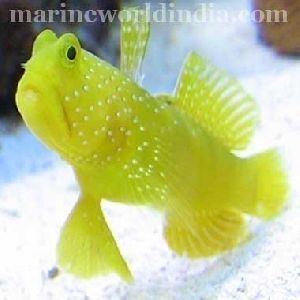
Yellow Watchman Goby fish
Description: The Yellow Watchman Goby also are called Yellow Watchman Prawn Goby, and sometimes the Yellow Shrimp Goby. Yellow Watchman Gobies are one of the more popular Shrimp Gobies offered in the pet trade. They seem to be very resistant to most saltwater fish disease in the marine aquarium. . Yellow Watchman Gobies form a mutual symbiotic relationship with some Pistol Shrimp. The name "Watchman" comes from their behavior in the wild, where they act as watchmen for the shrimp Minimum tank size: It requires a 1 gallon or larger aquarium Feeding and diet: Yellow Watchman Gobies may be kept on a diet of brine shrimp, large shrimp chopped into bits, and other meaty foods Reef Compatibility: Very good reef or community fish. Level of Care: Easy
...more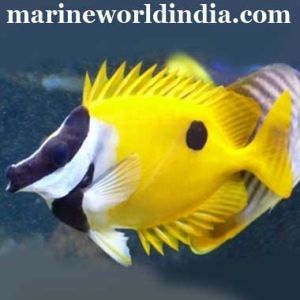
Yellow Rabbit Fish
Description: The Foxface Lo, also known as the Foxface Rabbitfish, has a very unique body color. It has a mottled yellow-brown body with a dark chest. The face is very light in color and speckled on the lower half. They are a very hardy fish, and are great additions to the newly-established tank. It may reside in a 125 gallon or larger aquarium. It is a very peaceful species except when housed with other rabbitfish. The Foxface Lo may be housed with more aggressive fish. Its predators will tend to leave it alone because of its venomous dorsal spines. Rabbitfish are generally reef-safe if they are well fed. If not, it is possible for them to nip at and consume some species of LPS and soft corals. The Foxface Lo diet consists of a variety of fresh vegetables and undesirable species of algae. It does nip and possibly eat some soft and hard coral polyps Minimum Tank Size: 125 gallons Feeding and Diet: Herbivore Reef Compatibility: With Caution Venomous: Yes Level of Care: Easy
...more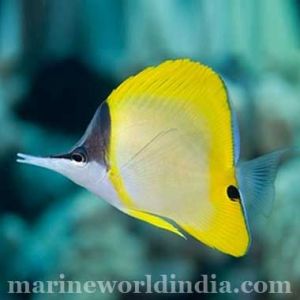
Yellow Long Nose Butterfly fish
Description: The Yellow Longnose Butterflyfish (Forcipiger flavissimus) is a species of butterflyfish in the genus Forcipiger. It is also known as the Forcepsfish Minimum Tank Size: It does best if kept in a 70 gallon or larger tank with peaceful tankmates Feeding and Diet: Carnivorous, feed marine fish, crustacean flesh, mysid shrimp and frozen preparations Reef Compatibility: Most individuals can be kept in a reef tank with most soft corals and small-polyped stony corals, although some may nip at large-polyped stony corals, certain soft corals (including xeniids and clavulariids) and zoanthids (e.g., Parazoanthus spp.) Level of Care: Moderate
...more
Yellow Eye Kole Tang fish
Description: This species is reddish-brown with lighter lines running down the body and a yellow ring around the eye. It is an active species that will graze on microalgae growing on the aquarium glass and décor. It is a passive tang that makes a great community fish. Very popular as a "maintainance" tang Minimum Tank Size: A 70 gallon or larger aquarium is necessary to provide plenty of swimming room Feeding and Diet: Herbivore Reef Compatibility: Great for a reef or community aquariums. Level of Care: Easy
...more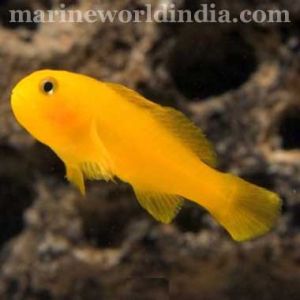
Yellow Clown Goby fish
Description: This is a fascinating fish to keep in the aquarium, especially in smaller tanks. It does best if housed with live or faux corals of the branching type. Members of this genus are thought to have a noxious body slime that deters most predatory fishes from feeding on them. Not aggressive towards other fish species, although it may fight with members of its own kind. The number you place in your tank should be a function of how many hiding places in available. These are very small, typically around 1" Minimum Tank Size: 1 gallon Feeding and Diet: It feeds on a variety of small crustaceans, vitamin-enriched brine shrimp (live or frozen), mysid shrimp, prepared foods for herbivores, and algae growing in the tank Reef Compatibility: Very good reef or community fish Level of Care: Easy
...more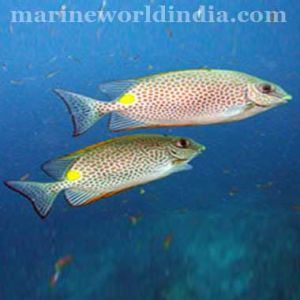
Yellow Blotch Rabbit Fish
Description: The Yellow Blotch Rabbitfish, also known as the Orange-Spotted Spinefoot, Orange Spotted Foxface Rabbitfish, or Gold Saddle Rabbitfish originates from the reefs of the Western Pacific. It's a species of increasing popularity with reef-keepers for its beauty and algae-eating activity. The body of Yellow Blotch Rabbitfish is brown and covered in many beautiful orange spots, a camouflage pattern that includes a distinctive posterior yellow false eye to confuse predators. Because of its venomous dorsal spines (which it can raise when disturbed) care must be taken when handling to avoid the possibility of being envenomated. It requires a 180 gallon or larger aquarium with plenty of open swim space. It is a very peaceful species except when housed with other Rabbitfish. The Yellow Blotch Rabbitfish may be housed with more aggressive fish and can be kept in pairs. Rabbitfish are generally reef-safe if they are well fed. If not, it is possible for them to nip at and consume some species of LPS and soft corals. Their diet should consist of alg ae sheets and other foods formulated for algae-eating fish Minimum Tank Size: 180 gallons Feeding and diet: Herbivore Reef Compatibility: With Caution Level of Care: Moderate Venomous: Yes
...more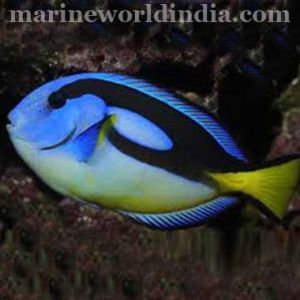
Yellow Belly Regal Tang fish
Description: The Yellow Belly Blue Tang is just a color variant of the Pacific Blue Tang. The only difference is that it has a yellow belly and is collected from the Indian Ocean. As juveniles the Yellow on its belly is barely visible, but as the fish gets larger the yellow will come out more and more Recommended Tank Size:Requires a 50 gallon or larger aquarium with a number of hiding places and plenty of room to swim.Though peaceful towards most tankmates, the Yellow Belly Hippo Tang will demonstrate aggressive behavior towards other fish of its own species. To keep multiple specimens, introduce the entire lot at once into the marine system Feeding and diet: In nature it feeds almost entirely on brown macroalgae and should be offered a wide a variety of foods including plenty of algae. Although Tangs will eat meaty foods along with the other fish in the aquarium, it is important that they are offered plenty of seaweed and algae. These are the foods that will strengthen their immune system, reduce aggression and improve their overall health. Offer dried seaweed tied to a rock or use a veggie clip, and feed at least 3 times per week Reef Compatibility: Good reef fish Level of Care: Easy
...more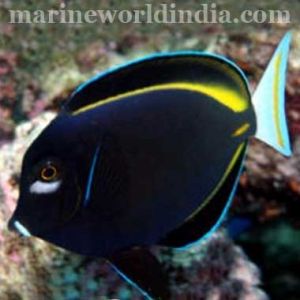
White Cheek Tang fish
Description: The Whitecheek Tang, is also known as the Gold-rimmed Surgeonfish or Powder black tang. The Whitecheek Tang is shy when introduced to the aquarium and will require suitable hiding places to refuge in if threatened. The Whitecheek Tang can be finicky when it comes to adjusting to eating prepared foods, so a tank with a flourishing algae crop or live rock will ensure it gets enough to eat during the acclimation process. Like most tangs, this species can be aggressive toward surgeonfish tankmates once it acclimates, especially members of its own kind (keep only one per tank) Minimum Tank Size: Requires a 70 gallon or larger aquarium with a number of hiding places and plenty of room to swim Feeding and Diet: In nature it feeds almost entirely on brown macroalgae and should be offered a wide a variety of foods including plenty of algae. Although Tangs will eat meaty foods along with the other fish in the aquarium, it is important that they are offered plenty of seaweed and algae. These are the foods that will strengthen their immune system, reduce aggression and improve their overall health. Offer dried seaweed tied to a rock or use a veggie clip, and feed at least 3 times per week Reef Compatibility: Great reef fish, fares notably better in reef aquariums than in fish only tanks Level of Care: Moderate
...more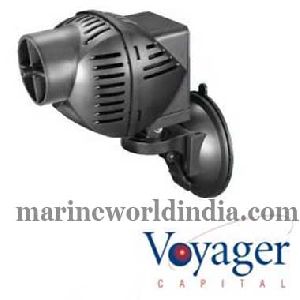
Wave Maker
Wave makers provide custom water movement in freshwater and saltwater aquariums. Proper water movement is important for promoting gas exchange, supplementing filtration and providing physical and mental activity for aquarium inhabitants.
...more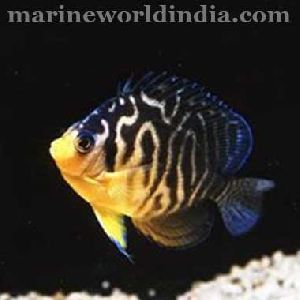
Venustus Angel fish
Description: The Venustus Angel is one of the more rarer species and therefore would make a beautiful addition to your aquarium. This fish has a beautiful bright yellow body with either a purple or blue triangular patch over the eye and saddle across the back. This is probably the most eye-catching features of the Venustus Angel. Also called the Purple Masked Angelfish, the Blue-Backed Angelfish, or the Purplemask Angelfish. Usually found in caves and deep reef slopes, the Venustus Angelfish needs to be acclimated to aquarium lighting in the same way many deep water anthias are. Requires open rock structure with caves and overhangs. The beautiful bright yellow body with the purplish/blue triangular patch over the eye and saddle across the back make this fish an unusual addition bound to attract the eye and conversation in any home aquarium Minimum Tank Size: Provide a 50 gallon or larger tank . It should have large amounts of live rock for hiding and grazing Feeding and Diet: In a saltwater aquarium they should be given a balanced diet. Variety is important, feed them foods from a wide range of food groups. Feeding them a single type of food for too long is generally a bad idea. They should be fed frozen foods that have both meat and algae Reef Compatibility: Reef Aquarium Compatibility Generally safe, but may nip at corals, clams, etc Level of Care: Moderate
...more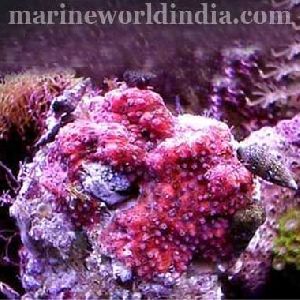
Vanuatu Live Rock
Descripion: Vanuatu live rock has a very rugged appearance that is excellent for aquascaping a new reef aquarium or for adding to an existing aquarium. For Vanuatu Live Rock we recommend only 11/2 -2 pounds pounds per gallon. For aquascaping, it is acceptable to alter the shapes and sizes of the rock with a hammer and chisel. This will not damage the integrity of the rock , or anything living within it. Please, just make sure you wear safety glasses. Vanuatu live rock will color up with more unique colors than normal Fiji rock. You will see purple, pink, red, yellow, and green coralline algae. When rocking your reef tank, it is acceptable to combine a few different islands rock. You may also alter the sizes and shape of your live rock with a hammer and chisel. This will not damage the integrity of the rock, nor it's inhabitants. Please be careful to wear eye protection if you are chiseling live rock
...more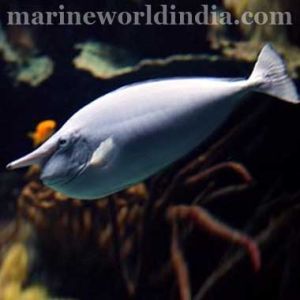
Unicorn Surgeon Fish
Description: The Unicorn Tang is also known as the Blue spined Unicorn Tang. The horn of the Unicorn develops when the fish is approximately 6 inches in size. Their color is silver as a juvenile and turns to a olive green hugh as the fish matures to its adult coloration. Its shape also will change from a more oval shape as a juvenile to a more bullet shape as it turns to an adult. Unicorn Tangs are much sought after by hobbyists, but not often collected. It needs lots of swimming room, not a tank cluttered with décor. Young individuals such as would be suitable for a home aquarium look little like the spectacular pictures of the giant specimens often seen in books, and have virtually no "horn"-- you simply do not see this in the trade. Unicorn tangs are generally passive, making good community fish. In the wild, juveniles feed on algae while adults eat zooplankton Minimum Tank Size: This handsome fish is very active; thus, it is important to provide it with plenty of swimming space. A minimum recommended tank size is 180 gallons Feeding and Diet: Herbivore Reef Compatibility: Yes Level of Care: Moderate
...more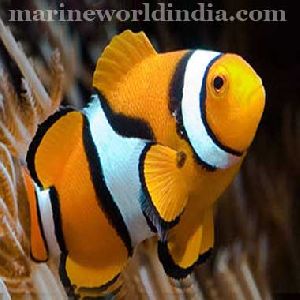
True Percula sea fish
Description:True Perculas are some of the most classic and popular clownfish species we offer. These docile fish are close relatives of the False Percula (A. ocellaris), and the two species can be easily confused. Both species have orange bodies with three white stripes. In the Percula, the black margin around the white stripes is thick while in the False Percula, the black margin is very thin or absent. They also have a different number of spiny rays in the dorsal fin. These two species do not overlap in their natural distribution. The true percula is found only in Melanesia and Northern Australia. Mature specimens typically develop a striking black coloration between stripes Minimum Tank Size:20 Gallon Feeding and Diet:Omnivorous, feed varied diet that includes plant material Reef Compatibility: Excellent Reef Fish Level of Care:Easy
...more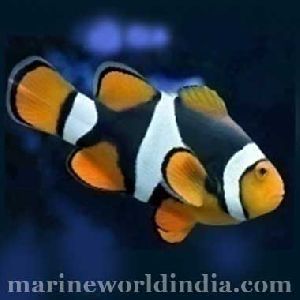
True Onyx Percula sea fish
Description:The Black Onyx True Percula Clownfish are found along the reefs off New Guinea. Black Onyx clowns carry the name Onyx because they grow up to have an abnormal amount of black coloration on their body as opposed to the majority orange of the common True Percula Clownfish. Minimum Tank size: 20 Gallon Feeding and Diet:Omnivorous, feed varied diet that includes plant material Reef Compatibility: Excellent Reef Fish Level of Care:Easy
...more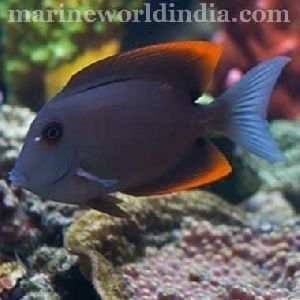
Tomini Tang fish
Description: One of the easiest saltwater fish to keep after acclimated, the Tomini Tang is a great fish for beginners with a sufficient sized aquarium. It is also the smallest of the Tangs, which makes it a great addition to the average home reef aquarium. The Tomini Tang is a typical member of the Ctenochaetus genus, meaning it is generally mild mannered and a good fish for a mixed community setting. They are also known to be a very effective grazer in the reef tank, keeping algae under control. Tomini Tangs will not bother not a single coral, clam, or invertebrate. When keeping more than one species of Tang, it is best to add them at the same time to a larger aquarium. When adding multiple Tangs to the same aquarium, it is best to have the Tomini in place prior to adding Tangs of a different genus Minimum Tank Size: requires a 50 gallon or larger aquarium with a number of hiding places and plenty of room to swim Feeding and Diet: In nature it feeds almost entirely on brown macroalgae and should be offered a wide a variety of foods including plenty of algae. Although Tangs will eat meaty foods along with the other fish in the aquarium, it is important that they are offered plenty of seaweed and algae. These are the foods that will strengthen their immune system, reduce aggression and improve their overall health. Offer dried seaweed tied to a rock or use a veggie clip, and feed at least 3 times per week Reef Compatibility: Great reef fish. Typically fares notably better in reef aquariums than in fish only tanks. Level of Care: Easy
...more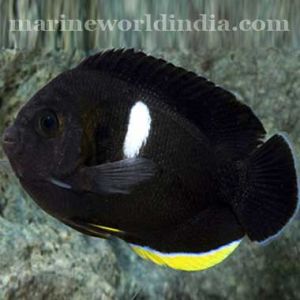
Tibican Angel fish
Description: The Tibicen Angelfish, is also referred to as the Melas Angelfish or Keyhole Angelfish. A sharp dresser, with their black coloration, white vertical saucer shape or keyhole in the center, a glowing blue outline on the finnage, and finally bright yellow on the pelvic and anal fins Minimum Tank Size: Provide a 50 gallon or larger tank. Like all mini angels provide live rock with holes and caves for hiding and grazing. To do well, the Tibecen angelfish needs to be kept in a reef type aquaria. We would not suggest a fish only tank without live rock because they need the live rock type of tank to survive long term. This is commonly due to specialized diet requirements that reef aquaria provide, in the way of naturally occurring micro-crustacean populations, but in some cases, may simply be due to the more complete natural ecosystem found in reef tanks Feeding and Diet: In a saltwater aquarium they should be given a balanced diet. Variety is important, feed them foods from a wide range of food groups including Spirulina, marine algaes, one of the quality frozen angelfish preparations on the market, along with mysis or frozen shrimp, and other meaty items Reef Compatibility: Generally safe, but may nip at corals, clams, etc Level of Care: Easy
...more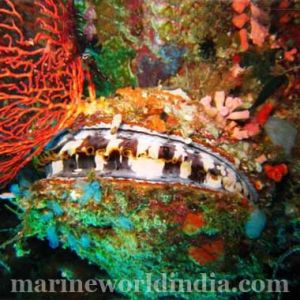
Thorny Oyster Spondyllus sp
Description: The Thorny Oyster is a beautiful addition to a reef aquarium. They can be found from 3 to 6 inches in size, are totally reef safe and will stay where placed in the aquarium Diet: Because Thorny Oysters have no photosynthetic properties, the Thorny Oyster eat only phytoplankton filtered from the ocean water. In an aquarium Thorny Oysters require excellent water quality and either frequent water changes for fresh food or the addition of an invertebrate food containing phytoplankton Reef Compatibility: Excellent in a fully seasoned reef aquarium
...more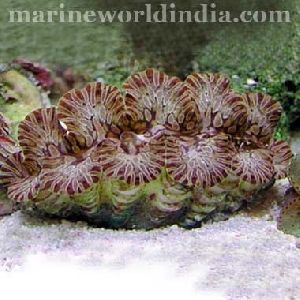
Teardrop Maximas
Description: Teardrop Maxima's name comes from the teardrop shaped markings on their mantles. For a long time good ones were hard to find. Now we have a new exclusive source for the most beautiful, Teardrop Maxima clams. They are being collected in a region close to the equator where the colors are the most brilliant in a large atoll in the middle of the Pacific Hardiness: T. maxima is a moderately hardy clam which usually does well in reef tanks given strong lighting and clear water conditions with low to moderate water flow Lighting: Requires fairly intense lighting, Metal Halide, VHO, or Power Compact depending on tank size. The clam coloration can change depending upon lighting conditions Water Current: Low to moderate Temperature: Does well within normal reef tank temperature ranges of 75-84°F Feeding: Primarily photosynthetic. They may benefit from feedings of phytoplankton, but it is not required. Supplements: Proper calcium levels (350-500 milligrams per liter) are important for growth as is maintaining good alkalinity levels Tank Positioning: Position on the substrate in the bottom of the tank in a low to moderate water flow area. Can also be positioned on live rock if care is taken to locate it so that it cannot move and fall from its perch
...more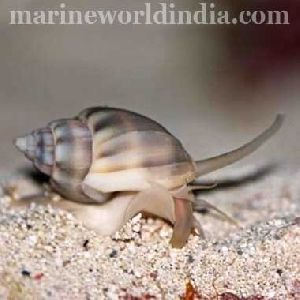
Super Tongan Nassarius Snails
Description: Nassarius snails are excellent for keeping the substrate stirred and clean. They usually stay buried and eat leftover food but may emerge as you feed the other aquarium residents. hey have beautiful ornamental shells, are fast movers, and are VERY hardy snails. You will see the nassarius snails emerge from beneath the sand when you drop food in the tank in a feeding frenzy Food and diet: They can be fed algae pellets, if they can't find enough natural food. 1 Conch per 25 gallons of water Recommended Minimum Tank Size: 1 gallon or larger Level of Care: Easy Reef Compatibility: Very good
...more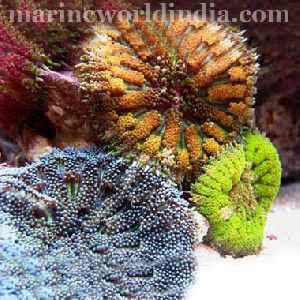
StichodactyLa Tapetum
Description: These are not died colors. This photo has not been touched up. Maxi Mini Carpet Anemone's are also called Pizza Anemone's. They are exceptionally hardy, easy to keep, and extremely simple to clone by cutting. Maxi mini carpets come from Vietnam. They came into the U.S. market about 5 years ago and only recently have the really nice colors been coming in. Unlike the mini carpet anemones, these maxi anemones come in a rainbow of colors and grow up to 5 inches. The maxi mini anemone is very easy to keep and acclimates within minutes when you introduce it into your tank. It prefers to live in rock and will move quickly to your rock work if you place it on a sand bed. A good suggestion is to have a few pieces of rubble rock around to place the anemones in so they won't move around too much. Once they are settled in to their spot with good light and decent flow, they will usually stay in one place. Most people keep their anemones under T5's, lower down in a tank with MH's, or under LED lighting. To see all the beautiful colors in Maxi Mini Carpet Anemones actinic / blue lighting is required to get the beauties to fluoresce under. Maxi mini carpets have a week sting compared to other anemones and other corals. They are not aggressive and you don't have to worry about them digesting your corals during the night, like some other corals would do. I would not advise putting them next to other types of anemones as the maxi minis will probably be damaged. You can keep several maxi mini carpet anemones together in a tank. Since they come in a variety of striking colors, a maxi mini tank is quite beautiful Diet: Though mostly photosynthetic, supplemental feedings of raw table shrimp, clam, mussel, silversides, squid and other marine based meats can be fed every few days. Pieces should be cut roughly to the size of the anemones mouth Care Level: Easy
...more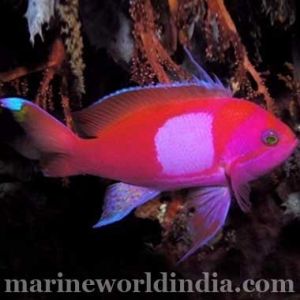
Square Back Anthias fish
Description: The Pink square anthias is the largest of the anthias family. They can attain a size of 4-5 inches and should be housed in at least a 75 gallon tank. They are a great schooling fish and are reef safe. They are of a peaceful temperment and get along with most community fish. The male is reddish pink with a bright pink square or blotch on the side. The female is a bright orange-yellow color Minimum Tank Size: 25 gallon tank will suffice for one fish, however, if keeping a group, a 125 gallon tank should be used since the Squareback Anthias appreciates plenty of room to swim Feeding and Diet: Anthias are planktivores and feed primarily on zooplankton, tiny animals found in the water column. They benefit from several small feedings throughout the day rather than one large feeding. A healthy microinvertebrate population in the aquarium with a constant supply of food items like copepods and amphipods is beneficial but most anthias can be weaned onto frozen and prepared zooplanktons, Cyclop-eeze, mysis shrimp, baby brine shrimp and similar items. Reef Compatibility: Great for a reef aquarium! Level of Care: Moderate
...more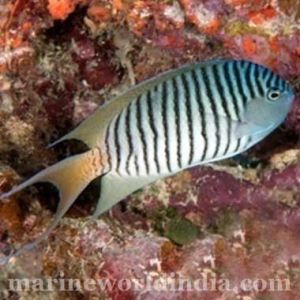
Spot breast angel fish
Description: With a highly-flared tail, the Spotbreast Angelfish is also referred to as the Blackspot Angelfish, Blackspot Lyretail Angelfish. The Spotbreast Angelfish is one of the few angelfish to exhibit dramatic sexual dimorphism. The female is yellow dorsally, and light blue ventrally. The caudal fin is marine-blue highlighted by a dark, blue-black edging on the top and bottom. The male is marked with a series of vertical red stripes covering the entire pale colored body. The tail of the male is forked and is yellow with blue edges. A minimum of a 125 gallon tank or larger with lots of hiding places and live rock for grazing will offer an environment in which to thrive. An exception to most angelfish, the Blackspot Angelfish will make a good reef dweller, and will not nip at stony and soft corals (sessile invertebrates). It is also more peaceful and may be kept as a mated pair, or in schools. Fish of the genus Genicanthus are the only zooplanktivores among the angelfish. The diet of the Spotbreast Angelfish should include Spirulina, marine algae, high-quality angel fish formulae food Minimum Tank Size: 125 gallons Feeding and Diet: Omnivore Reef Compatible: Yes Level of Care: Moderate
...more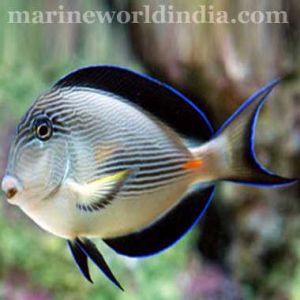
Sohal Tang fish
Description: This Stunning Red Sea fish is one of the boldest members of the tang family, it is also the hardiest, easiest to keep of them all!! This is a very active fish that needs plenty of swimming room; adults should be kept in larger aquariums. Minimum Tank Size: requires a 125 gallon or larger aquarium with a number of hiding places and plenty of room to swim. Feeding and Diet: In nature it feeds almost entirely on brown macroalgae and should be offered a wide a variety of foods including plenty of algae. Although Tangs will eat meaty foods along with the other fish in the aquarium, it is important that they are offered plenty of seaweed and algae. These are the foods that will strengthen their immune system, reduce aggression and improve their overall health. Offer dried seaweed tied to a rock or use a veggie clip, and feed at least 3 times per week. Sea Veggies, Seaweed Salad and Ocean Nutrition are all ideal products and are very easy to use. Reef Compatibility: Great reef fish. Typically fares notably better in reef aquariums than in fish only tanks. Level of Care: Easy
...more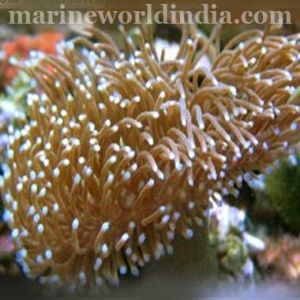
Soft Coral
Soft corals, are a great start for the marine aquarist graduating from fish to invertebrate to full-blown-reef enthusiast. Many soft corals are tolerant toward aquarium conditions, relatively inexpensive, and more easily cared for than the small or large polyped true or stony corals. Soft Coral Habitat: Soft corals rely on currents to bring them their food , oxygen, and carry away their wastes. The best circulation arrangements involve wavemaking strategies that periodically vary the direction and intensity of water movements. Remember that most soft coral species are found in parts of the reef with the greatest current. Filtration: Practically speaking, reef or invertebrate systems with soft corals require good filtration. An oversized protein skimmer, source of calcium replenishment, and use of activated carbon are all important items to consider. Lighting: All species of soft coral will appreciate 2-5 watts of full-spectrum illumination for 8-10 hours per day. Feeding: All species of soft corals are known planktivores, consuming phytoplankton in the wild. All soft corals should therefore be periodically offered such small offerings.
...more
Business Consultant

Maintenance Services
Be first to Rate
Rate ThisOpening Hours